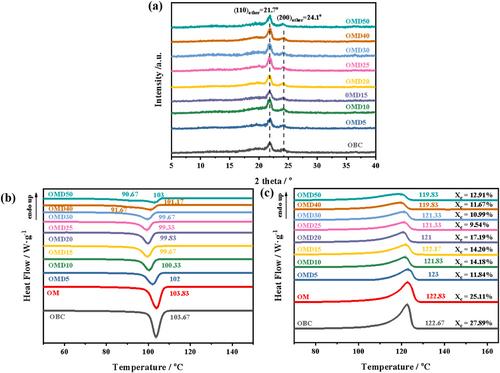Yu Kou, Yuqi Ma, Jialiang Li, Shilong Zhang, Jiaxun Cao, Hua Deng, Yanling Zhu, Yongsheng Zhao, Jianbin Qin, Guangcheng Zhang
求助PDF
{"title":"Reactive melt-grafting of maleic anhydride onto olefin block copolymer toward high-performance polar polyolefin thermoplastic elastomer","authors":"Yu Kou, Yuqi Ma, Jialiang Li, Shilong Zhang, Jiaxun Cao, Hua Deng, Yanling Zhu, Yongsheng Zhao, Jianbin Qin, Guangcheng Zhang","doi":"10.1002/pi.6627","DOIUrl":null,"url":null,"abstract":"<p>The block structure of olefin block copolymer (OBC) elastomer gives it good elasticity and heat resistance relative to other polyolefin elastomers. However, the non-polar nature of OBC chains limits its comprehensive properties like dyeing and toughening for polar engineering plastics. In this work, maleic anhydride (MA) and dicumyl peroxide (DCP) were selected as a typical polar monomer and a radical initiator to modify the polarity of OBC elastomer. During the melt-grafting process, the DCP content was tuned to optimize the grafting efficiency while the MA-to-OBC ratio was fixed at 5 wt%. It was found that all the melt-grafting reactions show high efficiency and can be finished in 3 min at 170 °C. With the increase of DCP content, the estimated grafting degree of OBC-<i>g</i>-MA elastomer increases from 0.40% to 1.16% along with increased gel content from 4.27% to 22.44%. A suitable grafting process was obtained with a DCP content of 3.0 wt% by balancing grafting efficiency and final mechanical properties. The optimized OBC-<i>g</i>-MA elastomer with a grafting degree of 0.92% has a mechanical strength of 17.15 MPa, a Young's modulus of 26.35 MPa, elongation of 1564% and strain recovery of 59.73%. Additionally, the contact angle test shows that polar grafting can increase surface hydrophilicity while excessive crosslinking promotes hydrophobicity. Therefore, our work has demonstrated the feasibility of the reactive melt-grafting method to prepare OBC-<i>g</i>-MA elastomer and can also provide a processing reference for other chemical functionalization of polyolefin thermoplastic elastomers. © 2024 Society of Industrial Chemistry.</p>","PeriodicalId":20404,"journal":{"name":"Polymer International","volume":"73 7","pages":"545-555"},"PeriodicalIF":2.9000,"publicationDate":"2024-03-05","publicationTypes":"Journal Article","fieldsOfStudy":null,"isOpenAccess":false,"openAccessPdf":"","citationCount":"0","resultStr":null,"platform":"Semanticscholar","paperid":null,"PeriodicalName":"Polymer International","FirstCategoryId":"92","ListUrlMain":"https://onlinelibrary.wiley.com/doi/10.1002/pi.6627","RegionNum":4,"RegionCategory":"化学","ArticlePicture":[],"TitleCN":null,"AbstractTextCN":null,"PMCID":null,"EPubDate":"","PubModel":"","JCR":"Q2","JCRName":"POLYMER SCIENCE","Score":null,"Total":0}
引用次数: 0
引用
批量引用
Abstract
The block structure of olefin block copolymer (OBC) elastomer gives it good elasticity and heat resistance relative to other polyolefin elastomers. However, the non-polar nature of OBC chains limits its comprehensive properties like dyeing and toughening for polar engineering plastics. In this work, maleic anhydride (MA) and dicumyl peroxide (DCP) were selected as a typical polar monomer and a radical initiator to modify the polarity of OBC elastomer. During the melt-grafting process, the DCP content was tuned to optimize the grafting efficiency while the MA-to-OBC ratio was fixed at 5 wt%. It was found that all the melt-grafting reactions show high efficiency and can be finished in 3 min at 170 °C. With the increase of DCP content, the estimated grafting degree of OBC-g -MA elastomer increases from 0.40% to 1.16% along with increased gel content from 4.27% to 22.44%. A suitable grafting process was obtained with a DCP content of 3.0 wt% by balancing grafting efficiency and final mechanical properties. The optimized OBC-g -MA elastomer with a grafting degree of 0.92% has a mechanical strength of 17.15 MPa, a Young's modulus of 26.35 MPa, elongation of 1564% and strain recovery of 59.73%. Additionally, the contact angle test shows that polar grafting can increase surface hydrophilicity while excessive crosslinking promotes hydrophobicity. Therefore, our work has demonstrated the feasibility of the reactive melt-grafting method to prepare OBC-g -MA elastomer and can also provide a processing reference for other chemical functionalization of polyolefin thermoplastic elastomers. © 2024 Society of Industrial Chemistry.
将马来酸酐反应性熔融接枝到烯烃嵌段共聚物 (OBC) 上,形成高性能极性聚烯烃热塑性弹性体
与其他聚烯烃弹性体相比,烯烃嵌段共聚物(OBC)弹性体的嵌段结构使其具有良好的弹性和耐热性。然而,OBC 链的非极性限制了其在极性工程塑料中的染色和增韧等综合性能。本研究选择马来酸酐(MA)和过氧化二异丙苯(DCP)作为典型的极性单体和自由基引发剂来改变 OBC 弹性体的极性。在熔融接枝过程中,调整 DCP 的含量以优化接枝效率,同时将 MA 与 OBC 的比例固定为 5 wt%。研究发现,所有熔融接枝反应都表现出高效率,在 170 °C 下 3 分钟内即可完成。随着 DCP 含量的增加,OBC-g-MA 弹性体的估计接枝度从 0.40% 增加到 1.16%,凝胶含量从 4.27% 增加到 22.44%。通过平衡接枝效率和最终机械性能,在 DCP 含量为 3.0 wt% 时获得了合适的接枝工艺。接枝度为 0.92% 的优化 OBC-g-MA 弹性体的机械强度为 17.15 兆帕,杨氏模量为 26.35 兆帕,伸长率为 1564%,应变恢复率为 59.73%。此外,接触角测试表明,极性接枝可增加表面亲水性,而过度交联则会增加疏水性。因此,我们的工作证明了反应熔融接枝法制备 OBC-g-MA 弹性体的可行性,也可为聚烯烃热塑性弹性体的其他化学功能化提供加工参考。本文受版权保护。
本文章由计算机程序翻译,如有差异,请以英文原文为准。


 求助内容:
求助内容: 应助结果提醒方式:
应助结果提醒方式:


